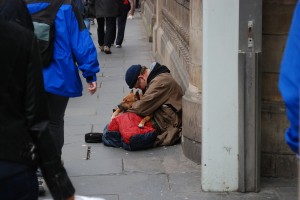 Not so long ago, the New York City Rescue Mission, made a stirring video of an experiment that questioned the invisibility of the homeless. In the experiment, make-up and wardrobe artists dressed actors as homeless people, placed them in the pathways of their loved ones, and waited for any signs of recognition. It didn’t happen. Husbands, sisters, brothers and friends of loved ones trudged along, oblivious to the plight of the loved ones seated by the street sides.
Not so long ago, the New York City Rescue Mission, made a stirring video of an experiment that questioned the invisibility of the homeless. In the experiment, make-up and wardrobe artists dressed actors as homeless people, placed them in the pathways of their loved ones, and waited for any signs of recognition. It didn’t happen. Husbands, sisters, brothers and friends of loved ones trudged along, oblivious to the plight of the loved ones seated by the street sides.
Watching the video for the first time, I was at loss about what the video expected of me. I do notice homeless people seated along my pathways, but I am afraid of making eye contact with them. I am afraid of the possibility of questioning the universe for placing them in their situation, and me in mine. I am afraid of the stories that placed them in their various positions, stories that could very easily be mine. I too would have failed this experiment.
I am not the only one, I realize after reading comments posted by viewers on YouTube. For some, it seems unfair of anyone to expect one to recognize a loved one dressed in homeless costumes. Others cry foul at a video that wants them to stare at the plight of the homeless. And others still, wonder whether the video expects them to offer change or sandwiches to the homeless. I might belong in this latter category. How does offering sandwiches or change solve the ubiquity of homelessness? How does a $5 note change the plight of a homeless drug addict? It might actually leave them worse than it found them, argues one of the video’s viewer. In the face of homelessness, therefore, I am confronted by my own powerlessness. I recognize my inability to solve the problem, and each encounter with it reminds me of my helplessness. I must take no notice of the homeless, in order to not confront my own weakness.
One YouTube commenter argues that there is a fine but crucial distinction between homelessness and the homeless. She argues that this video, addresses the plight of the homeless, and not the problem of homelessness. Other commenters, agreeing with her, believe that our recognition of the homeless as people, our smiles at them, and our nods in their direction, restore their sense of personhood and human dignity. I refuse to recognize the distinction between homelessness and the homeless. And more, importantly, I refuse to believe that deprived of the basics of shelter and food, basics that were easily accessible to the homo erectus and homo sapiens before us, a person will feel dignified by smiles and nods directed their way. I admit that I would have failed had I been a loved one in this video. Nevertheless, I ignore all its apparent flaws and choose to argue that this video is a call for people to rise to action. It is a provocation of sorts.
Yet, it is not a call for people to hand out change, to make sandwiches, or to nod and smile at the homeless. It is a call for a much greater responsibility. It is a call to confront both the plight of the homeless we encounter, and the bigger problem of homelessness that faces our cities. It is a call to combine cognitive and financial resources in a dedicated attempt to create innovative solutions that solve homelessness. We applaud the likes of Jobs and Zuckerberg in changing the way we live. We praise their capacity for innovation, for creativity, for actualizing creation. We need similar minds to rise to action to solve the problems such as those of homelessness. This video does not leap the bounds of explaining what any of us can do. But it brings the subject to the fore of our minds, and to our conversations, written or spoken.
The truth, however, is that though many problems are alive in our minds and mentioned in our conversations, they remain unsolved. Not for lack of creative talent that can solve them, but for lack of leadership that can direct this talent to solve them. Hopefully this video livens the problem of homelessness in the minds of responsible leadership, and motivates the harnessing of talent towards such problems as homelessness.
https://www.youtube.com/watch?v=u6jSKLtmYdMPhoto Credit
Homeless – By Benjamin Brock – Wikipedia Creative Commons
Guest Author Bio
Nkatha Gitonga
 Nkatha Gitonga is a rising senior at Harvard College studying Sociology and Global Health and Health Policy. She is currently a Marketing Assistant at Argopoint, a Legal Services Consulting firm in Boston.
Nkatha Gitonga is a rising senior at Harvard College studying Sociology and Global Health and Health Policy. She is currently a Marketing Assistant at Argopoint, a Legal Services Consulting firm in Boston.
Blog / Website: http://www.argopoint.com/
Recent Guest Author Articles:
- New Career and Degree Paths for Educators Who Want to Make a Broader Impact
- Finding the Right Plumber in Portland: A Comprehensive Guide for Homeowners
- Why Choose Elara Caring for Jackson, MI Home Health Services?
- How I Turned Poetry into a Paycheck
- Home Is Where the Health Is: Simple Shifts for a Happier You


Thanks Charalee. The video was made by the New York Rescue Commission. It’s amazing how unless we’re reminded, we sometimes risk forgetting those in need
I found your video a good way to raise awareness of the issue of homelessness. I will share the video with people I know who are addressing this issue in cities in Canada.